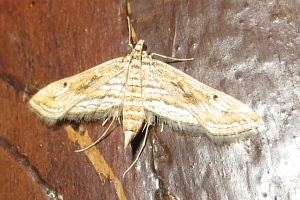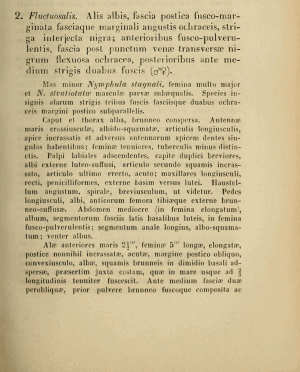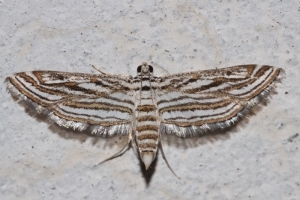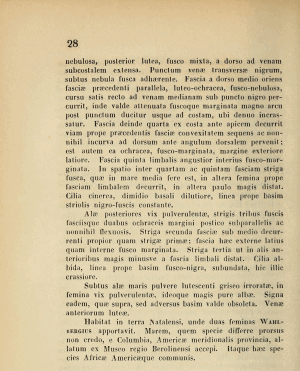

 +10Kontinente:EUASAFOC
+10Kontinente:EUASAFOC2. Diagnose
2.1. Erstbeschreibung
3. Biologie
3.1. Nahrung der Raupe
- [Hydrocharitaceae:] Hydrilla verticillata (Grundnessel, Wasserquirl)
- [Nymphaeaceae:] Nymphaea sp. ? (Seerose ?)
- [Cyperaceae:] Cyperus brevifolius ? (Kurzblättriges Zyperngras, Kurzblättriges Zypergras)
- [Commelinaceae:] Commelina diffusa ? (Blaue Tagblume ?)
- [Poaceae:] Paspalum conjugatum ? (Carabao-Gras, Hilo-Gras ?)
- [Poaceae:] Leptochloa chinensis ?
- [Poaceae:] Oryza sativa ??? (Reis ???)
Nach Goater et al. (2005) lebt die Raupe an Reis (Oryza sativa) und anderen aquatischen Süßgräsern (Poaceae), ganz ausnahmsweise auch an Seerose (Nymphaea). Bezüglich des Reis werden dabei die uralten Fehler wiederholt, die schon mehrfach korrigiert wurden: P. fluctuosalis ist nicht nur kein Reis-Schädling, sondern die Raupe kann sich von dieser Pflanze überhaupt nicht ernähren!
Im Abstract von Litsinger & Chantaraprapha (1995) heißt es: "The host plant range of two ricefield caseworms, Parapoynx fluctuosalis (Zeller) and P. diminutalis Snellen (Lepidoptera: Pyralidae), was determined from screening rice and 61 weeds in the Philippines. Both species developed best on the aquatic weed Hydrilla verticillata (L.f.) Royle (Hydrocharitaceae). Parapoynx fluctuosalis also completed a full generation from egg to egg on Cyperus brevifolius (Rottb.) Hassk. (Cyperaceae), Commelina diffusa Burm. f. (Commelinaceae), Leptochloa chinensis (L.) Nees, and Paspalum conjugatum Berg (Poaceae). Parapoynx diminutalis completed a generation on Chara vulgaris L. (Characeae), Ottelia alismoides (L.) Vahl and Blyxa auberti Rich. (Hydrocharitaceae), and Cyperus rotundas L. (Cyperaceae)."
Litsinger & Chantaraprapha (1995) stellten konkret fest: “Parapoynx fluctuosalis (Zeller) is reported to damage rice (Corbett, 1936; Williams, 1944; Zimmerman, 1958; Hanson, 1963). However, because it often occurs together with N. depunctalis there is confusion as to whether it feeds on rice or not (Shoff, 1919). It appears in numerous rice insect pest lists in Asia (Cendana & Calora, 1967; Alam, 1977) and Africa (Roger and Commun, 1959), but there is no confirming report that it feeds in rice.”
“Parapoynx fluctuosalis and P. diminutalis larvae cannot exploit the aerial foliage of a rice plant. They are truly aquatic species in which larval and pupal development occur under submergence.”
Wie vorsichtig man bei der Interpretation von Nahrungspflanze sein muss, zeigen sehr schön die Ausführungen von Litsinger & Chantaraprapha (1995), die hier doch etwas ausführlicher zitiert seien: “There was no evidence that either P. fluctuosalis or P. diminutalis can develop on rice. In no-choice trials, all 100 larvae of each species died within 3 days. However, moths readily oviposited on rice leaves. No reports on the host range of P. fluctuosalis were found, although two studies with P. diminutalis corroborated our results, that rice is not a host. […] Parapoynx diminutalis has never been reported to feed on rice but the numerous observations with P. fluctuosalis as a rice pest could not be corroborated. Confusion could have existed from finding P. fluctuosalis larvae within cases made from rice leaves. Hydrilla verticillata commonly occurs in irrigation canals; and P. diminutalis and P. fluctuosalis could have been swept into ricefields from irrigation canals after heavy rains. There may have been a mixture of either P. diminutalis or P. fluctuosalis with Nymphula depunctalis in the ricefields. Scraping damage to rice caused by N. depunctalis could have been mistaken as coming from the other caseworms. Parapoynx fluctuosalis and P. diminutalis could have made cases from rice leaves to further confusion.”
Aus ihrer Zucht ist zu erfahren: „Parapoynx fluctuosalis can complete a generation on five plant species within four families of Monocotyledoneae. Based on development parameters […] the order of suitability of hosts is: H. verticillata (Hydrocharitaceae) > Cy. brevifolius (Cyperaceae) > Co. diffusa (Commelinaceae) > P. conjugatum (Poaceae).”
4. Weitere Informationen
4.1. Andere Kombinationen
- Nymphula fluctuosalis Zeller, 1852 [Originalkombination]
4.2. Synonyme
- Oligostigma chrysippusalis Walker, 1859
- Hydrocampa circealis Walker, 1859
- Nymphula luteivittalis Mabille, 1880
4.3. Unterarten
- Parapoynx fluctuosalis linealis Guenée, 1854 [Unterart nach funet.fi]
4.4. Faunistik
Die Art wurde nach zwei Weibchen aus Natal in Südafrika (KwaZulu-Land) beschrieben: "Habitat in terra Natalensi". Nach Goater et al. (2005) ist die ssp. fluctuosalis über ganz Afrika und Südeuropa verbreitet, ssp. linealis über die Subtropen und Tropen von Asien, Australien, die Pazifischen Inseln und Mittel- und Südamerika. In Europa beschränkt sich das Vorkommen auf den Süden von Portugal und Spanien, sowie Sardinien. Angaben aus England beziehen sich auf mit tropischen Wasserpflanzen verschleppte Tiere in einer Gärtnerei. Auf der Artseite auf hantsmoths [Artseite auf hantsmoths.org.uk] ist hierzu zu erfahren: "Recorded infrequently through accidental importation in aquatic plants from the Far East. First discovered in Britain at Enfield, Middlesex in July 1979." - es müsste sich also um die asiatische Unterart gehandelt haben.
(Autor: Erwin Rennwald)
4.5. Literatur
- Goater, B., Nuss, M. & Speidel, W. (2005): Pyraloidea I (Crambidae: Acentropinae, Evergestinae, Heliothelinae, Schoenobiinae, Scopariinae). - In: Huemer, P. & Karsholt, O. (Hrsg.): Microlepidoptera of Europe 4: 1-304.
- Litsinger, J.A. & N. Chantaraprapha (1995): Developmental Biology and Host Range of Parapoynx fluctuosalis and P. diminutalis Ricefield Caseworms. — International Journal of Tropical Insect Science volume, 16: 1–11. [https://doi.org/10.1017/S1742758400018257] [zum Artikel auf researchgate.net]
- Erstbeschreibung: Zeller, P. C. (1852): Lepidoptera Microptera, quae J. A. Wahlberg in Caffrorum terra collegit. — Kongl. Vetenskapsakademiens Handlingar 1852: 1-120. Stockholm (P. A. Norstedt & Söner).















